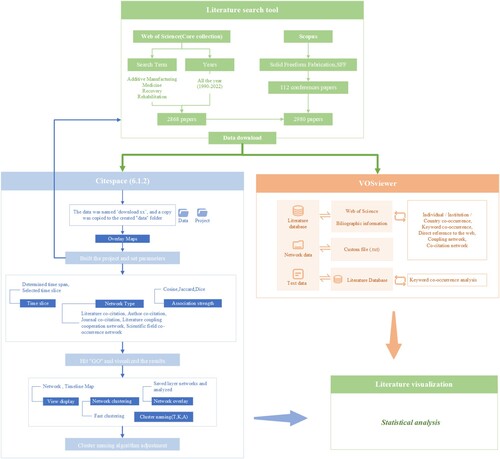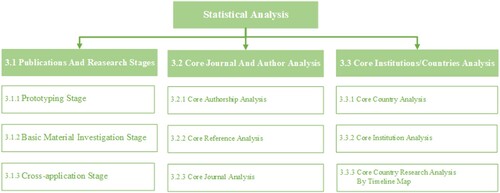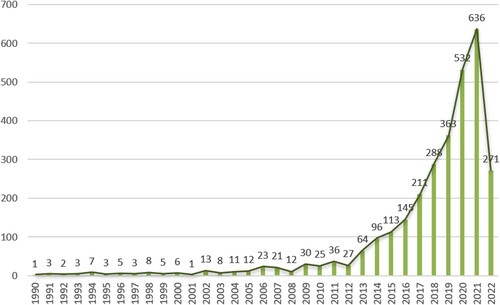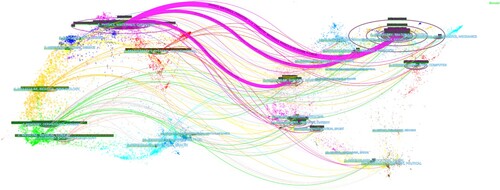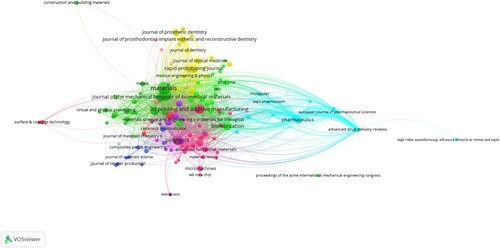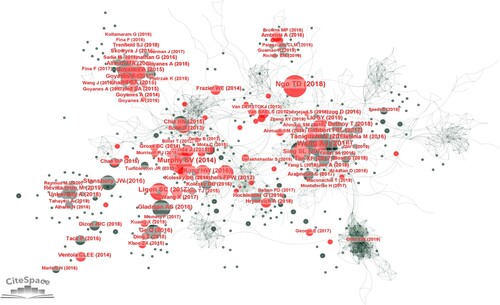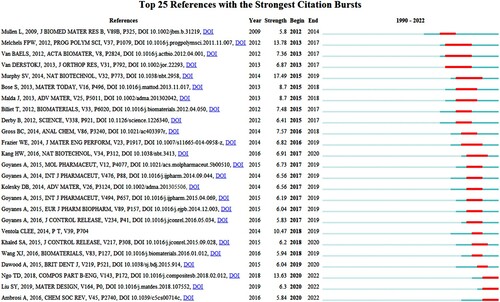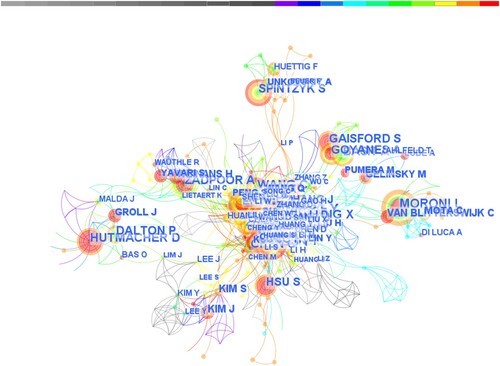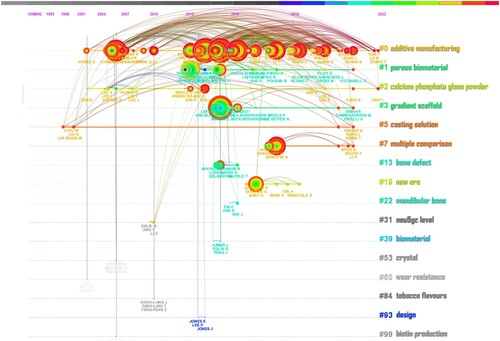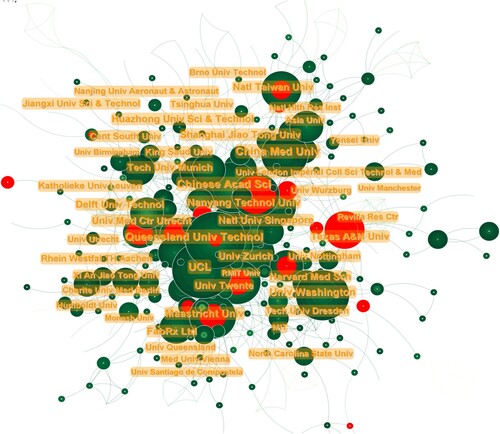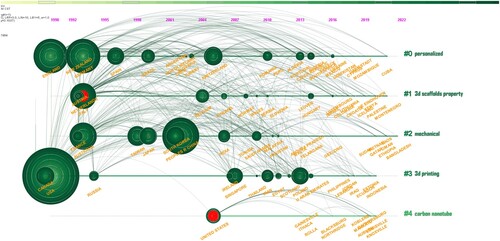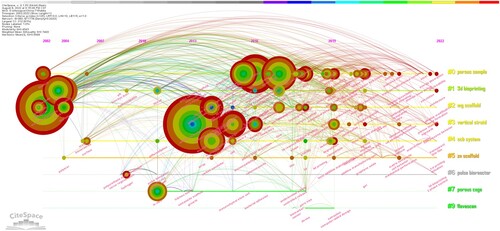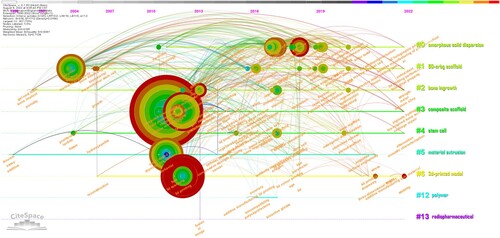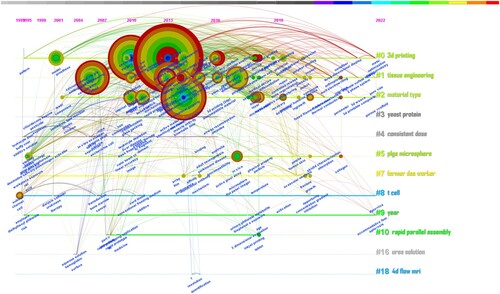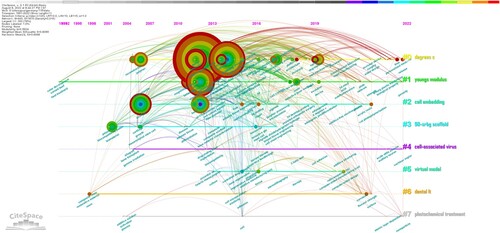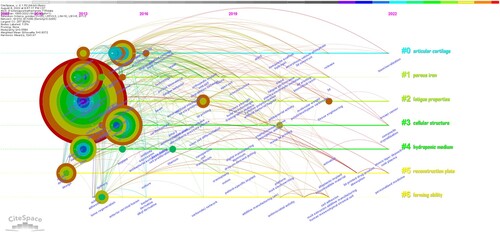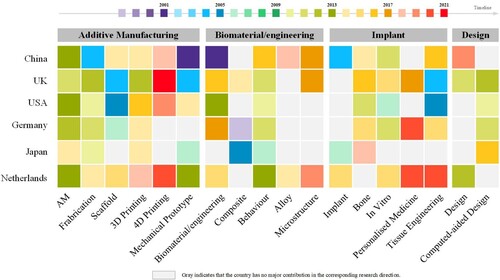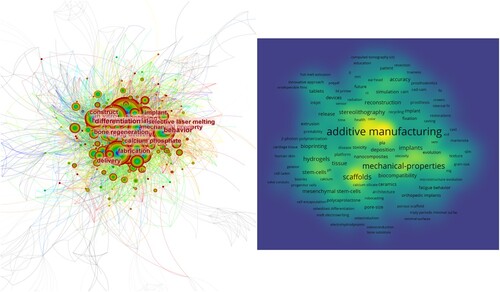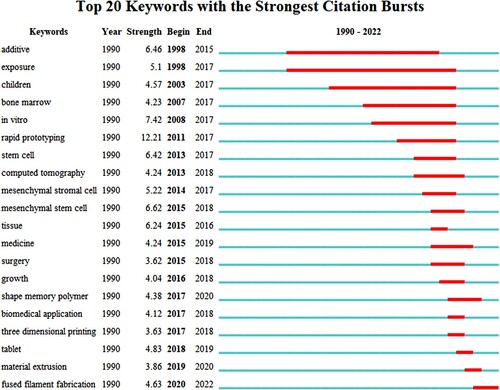ABSTRACT
Rehabilitation medicine (RM) requires more personalisation than any other treatment in the medical domain. Additive manufacturing (AM) is a promising candidate for providing customised tools to improve performance but reduce cost and complexity of personalisation. Research and applications of AM in the RM field are receiving increasing attention. This paper aims to identify the research status and development trend via visual analysis of literature. At first, core publications from representative domain journals and conference proceedings were extracted as source data for the inputs of statistical analysis. Secondly, keyword visualisation analysis provides research hotspots and technological developments to summarise the research frontiers. Finally, visual knowledge graphs were constructed to show the emerging trends, including digital solutions, lifecycle treatment, and multiple-supporter rehabilitation services, in this special interdisciplinary field. Specially, digital methods with AM and associated services will be one of the principle roadmaps for personalised RM in the future.
1. Introduction
The World Health Organization (WHO) defines rehabilitation as the application of all measures to alleviate the conditions of disability and handicap, improve the functioning of the sick, injured and disabled, and make it possible for them to become socially integrated without discrimination, and to reintegrate the disabled into society. Rehabilitation was not only the training of the disabled to adapt to their surroundings but also was the adjustment of their surroundings and social conditions to restore, compensate or re-establish their functions to the greatest extent possible so as to achieve the best functional status, improve the quality of life and enable the sick, injured or disabled to reintegrate into society (Andelic et al. Citation2020). ‘Rehabilitation medicine’ in a narrow sense refers to the use of medical treatment to promote rehabilitation. ‘Rehabilitation medicine’ is a ‘field’ that involves various clinical disciplines and includes all patients in need of treatment. From a medical point of view, patients were diagnosed, evaluated and treated by various medical means to promote the recovery of their bodily functions (Mauritz Citation1996). Rehabilitation medicine (RM) was a first-level discipline alongside clinical subjects such as the internal medicine department, chirurgery, gynaecology and paediatrics (Giacino et al. Citation2018). The main tasks of RM research included the prevention, assessment, treatment, training, and therapy of disabilities and handicaps, to eliminate and alleviate the functional impairment of patients, compensate and reconstruct their functional defects, and strive to improve their self-care ability and quality of life (Correia et al. Citation2014).
With the development of engineering technology, researchers have begun to use advanced manufacturing techniques to solve complex problems in RM. For example, to restore a patient's motor function, in addition to medical specialty approaches and exercise rehabilitation (Steele et al. Citation2003), physicians could often use standard therapy and innovative additive manufacturing-related rehabilitation techniques (Chaparro-Cárdenas et al. Citation2018), surgical plans (Thomas, Azmi, and Tehrani Citation2014), rehabilitation programmes (de Carvalho Filho et al. Citation2020) and custom rehabilitation products (Chaparro-Cárdenas et al. Citation2018). Researchers could use AM technology to develop low-cost (Palazzi et al. Citation2021) and high-performing customised personalised programmes (Silva et al. Citation2017).
As medical disciplines become more widely distributed, researchers are committed to more detailed research and technical application attempts. Although there was an increasing interest in adopting AM in the medical field, more cross-application technologies for RM had been explored from patient rehabilitation methods (Stephens-Fripp et al. Citation2020) and pharmaceutical treatment methods (Dumitrescu et al. Citation2018), and their applications had been extended to different fields in countries around the world. In contrast, the research roadmap of AM in the field of rehabilitation is still unclear, and there is a lack of statistical analysis of globalisation and no systematic research guidelines for research directions.
To meet this need, this paper attempts to use knowledge graph (KG) methods and bibliometric analysis tools to conduct both quantitative and qualitative analysis to generate visual knowledge graphs to help researchers and other interested readers better understand the cross-application research of AM in the field of RM. To realise the comprehensive analysis, up to 2965 research papers are selected from the main databases, including Web of Science (WOS), Scopus and EI village as well as an AM special database, solid freeform fabrication conference proceedings (SFF). Those selected literature references are analysed by using clustering and other statistical functions with the support of two famous bibliometric software tools, Citespace and VOSviewer. By integrating the analysis results, a set of synthesis visual knowledge graphs, which show the co-occurrence network, timeline map, key research players and related directions, geographical information, the evolution history and research focus of the field, are obtained. Based on the comprehensive analysis, the research hot spots and trends of AM technology in the field of RM are identified and discussed. The main contributions of this study are outlined as follows.
Via the use of visual statistical analysis, the paper systematically summarises and sort out the development, evolution and research trend of AM application in RM.
By using comprehensive statistical analysis, the research hotspots and key research groups and their interrelationships with AM applications in the field of RM are identified and visually represented.
The application and research overview of AM in the field of RM is summarised and visualised in knowledge graphs. This should have an important reference value for future work and decision-making of the public service departments in the RM domain.
2. Analysis method
The visual KG is widely used in various disciplines as a comprehensive discipline involving computer graphics, computer vision, KG, big data, human–computer interaction and other fields. Researchers are currently working on developing various types of visualisation software to calculate big data literature and perform multidimensional scientometric analysis, which can help more researchers sort out the relevant knowledge networks in the field of study and present a scientific, colourful and beautiful visualisation graph of literature knowledge by realising the basic functional requirements of visualisation on a non-tedious and boring basis (Hou, Yang, and Chen Citation2018).
There are many tools for generating visual knowledge graphs, such as Bibexcel, Citespace, IN-SPIRE, VOSviewer, CoPalRed and so on (Chen Citation2017). Citespace has a powerful statistical analysis of the literature and relatively large adjustable parameters, it can be adjusted to produce a scientifically beautiful literature visualisation graph (Chen and Song Citation2019). And VOSviewer has better node clustering capability and can quickly generate clustering maps for large data (van Eck and Waltman Citation2017). To better generate visual knowledge graphs and integrate meaningful visual knowledge graphs, this paper adopts two bibliometric tools, Citespace and VOSviewer, to support the statistical analysis. The combined use of the two tools can obtain comprehensive literature visualisation with more dimensional data and visual charts in various forms to help better understand the statistical analysis results.
2.1. Data preparation
The literature data source for this study is derived from two main parts. The first part is the core collection of WOS, which is currently a more complete and scientific tool for indexing the literature. The second part is collected from SFF, which is recognised by researchers in the field of AM as one of the most professional forums in the field.
Firstly, ‘Additive Manufacturing’, ‘rehabilitation’, ‘recovery’ and ‘medicine’ are set as keywords to screen in the WOS core dataset with the period from 1990 to 2022. After filtering, 3102 articles, which are related to AM and RM domains are circled out. Secondly, since there would be non-medical related content in AM related papers, a second screening step is conducted in the AM reference list to exclude non-medical content but only keep the reference list with contents of both AM and RM. The screening yields a total of 2868 article records for the period of 1990-2022. In addition, when selecting relevant literature in SFF, we also search relevant literature on Scopus, and EI village search platforms by checking important information such as titles, abstracts and keywords, and finally manually identified 112 conference papers related to RM. Thus, a total of 2980 articles are selected for subsequent analysis. To avoid any duplication, the literature data deduplication process is implemented, and finally, we obtain a total of 2965 articles in the refined list. The final data retrieval is supplemented on July 18 2022. shows the details of the retrieved articles.
Table 1. The details of the search article.
2.2. Analysis processes
Firstly, we import the data source exported from the WOS core collection data set into Citespace and VOSviewer, and use the basic functions of WOS to count the number of published papers in the past 30 years. Then, Citespace is applied to generate a visual map of journal distribution, subject distribution, author cooperation distribution and timeline maps of the country. After that, keyword co-occurrence network analysis is conducted. Finally, the cluster results generated in the two tools above are combined to conduct integrated statistical analysis to further produce simplified and multi-dimensional visual knowledge graphs, which could show the frontier hotspots in the field of RM, and summarise the application research trend of AM in RM. shows the specific process of generating a literature visualisation.
3. Statistical analysis
This paper presents the statistical analysis of the literature in three sections. The first section concerns the statistics of the number of papers published and the summary of the research phase. Based on the analysis of this part, we could visually find that over the past 32 years, there is an increasing trend of research interest in AM, from its technical study to its application in RM. The second part is the analysis of core journal and author. Core journals to some extent delineat the research directions of researchers in the subject area (Kim and Chen Citation2015). Researchers are closely associated with journals, and landmark publications by researchers could also be analysed in relation to subject areas. This section of literature visualisation could help us to analyse the new emerging hot research directions and the new interdisciplinary disciplines generated when AM technology is applied to RM. The third part is the analysis of core institutions and countries. By analysing the collaborating institutions or countries in a particular field, the distribution of major research forces could be quickly understood. By analysing the research directions and main contributing countries (China, the USA, Germany, the Netherlands, Japan and the UK) timeline map helps researchers to sort out the regional trends and research applications of research directions. And this can also provide a clearer understanding of the research directions that researchers around the world have focused on over the past 32 years, and distill key research priorities. shows the detailed structure of chapter 3 presenting the main analysis in three sections.
3.1. Publications and research stages
The publication of journal papers and conference articles is an important form of scientific research activity, it can directly reflect the author's scholarly activity and the research hotspots at the time at various stages (Chen Citation2006). The number of articles can also be a more intuitive reflection of changes in the research fervour in the field (Kim and Chen Citation2015). In this paper, the articles are counted by using an Excel tool. shows the statistics of the number of articles published on AM technology in RM from 1990 to 2022. In the early 1980s, researchers had been working on the integration of AM with RM. Since then, AM technology has been widely developed and applied in the field of RM. Three stages can be separated via the observation of the publication curve and publication content types and numbers in : the prototyping stage (1990–2001), the basic material investigation stage (2002-2014) and the cross-application stage (2015-2022).
3.1.1. Prototyping stage (1990-2001)
In the first stage (1990-2001), the research of AM technology just begin, many of the proper names or formal terms are not defined, and the number of published papers is relatively small and an annual average of about five. Therefore the stage can be considered as the prototyping stage. In 1995 at MIT, the NSF Design and Manufacturing Recipients Conference published a conference paper on 3D printing (3DP), on behalf of 3DP technology began development (Taylor et al. Citation1995), which was the breakthrough point of this manufacturing technology. This is the stage when the conceptual terminology of AM technology is clarified, from rapid prototyping, scaffold and fabrication to 3DP and later 4D printing (4DP). Researchers clarify the definitions of related terms in about 10 years. The articles published at this stage are mainly from the USA, with only a few researchers from other countries such as the UK and Germany approaching and studying 3DP technology and applying it to existing engineering fields, with less integration in RM.
3.1.2. Basic material investigation stage (2002-2014)
During the second stage (2002-2014), the number of publications grows rapidly, to nearly 1000 and many research results are emerging. The investigation of basic materials, the study of the microstructure of materials, the mechanical properties of products, the study of the process of material polymerisation, and the optimisation of basic materials and process methods led to the steady development of AM technology (Oliveira, LaLonde, and Ma Citation2020). And more researchers are working on specialised materials rich in growth factors that can assist in the rehabilitation of fracture sites. So this stage is the basic material investigation phase. Since 2009, the average number of publications exceed 100 per year in the context of RM applications of AM. In addition, international conferences and journals such as SFF, Additive Manufacturing, and Polymers are held every year to promote the intersection of AM technology with other disciplines, as well as the application and development of RM and to accelerate the exchange and cooperation of research on AM technology among countries.
3.1.3. Cross-application stage (2015-2022)
In the third stage (2015–2022), research on AM technology applied to RM continues to increase until it peaks in 2019 with 363 publications. During this stage, the total number of publications reaches 2559. With the development of AM technology from basic materials research to multidisciplinary crossover applications, AM crosses over with more and more disciplines from 3DP in the beginning to 4DP, to smart materials, and computer-aided engineering design. This development results in emerging disciplines such as biomedical engineering and 3D bioprinting. So this stage can be regarded as the multidisciplinary application phase, from microscopic drug release to stent and splint manufacturing, to large RM machinery and equipment. AM technology applied to RM are studied by many countries in recent years and would remain a key area in the future.
3.2. Core journal and author analysis
3.2.1. Core journal analysis
Core journals had a high degree of professionalism, a large amount of information, and a high quality, which could represent the development level of professional disciplines and was valued by researchers in various disciplines (Chen and Song Citation2019). To understand the key disciplines of the application of AM technology in the field of RM from a macro level, we use Overlay Maps to analyse the distribution of disciplines.
In the literature visualisation graph, the Overlay Maps of the scientific literature map represented the dataset of almost all journals (Chen and Leydesdorff Citation2014), and the map is generated by more than 3000 journals indexed by WOS. After selecting the Overlay Maps column, we selected the JCR-Journey Map function, imported the retrieved data source, clicked the z scores checkbox and adjusted the radius size of the circle representing the number of publications. Finally, we generate a visualisation of , with blue serial numbers and text marking all current research focus disciplines. When the two graphs are overlaid, the left-hand side (left half) represents published journals and the right-hand side (right half) represents cited journals, as shown in . The citation relationships between published and cited journals are marked on the arcs from left to right.
Table 2. Subjects in the overlay maps.
The cited articles represented to some extent the application of new technologies and concepts (Hou, Yang, and Chen Citation2018). As shown in , the published literature on the left lead to three main purple arcs to the cited literature, representing the relationship between the published and cited disciplines of the literature. And it also represents the main research discipline of the application of AM technology to RM.
Physics, Materials, Chemistry -> Chemistry, Materials, Physics
Physics, Materials, Chemistry -> Environment, Toxicology, Nutrition
Physics, Materials, Chemistry -> Molecular Biology, Genetics
Table 3. Eight major disciplines analyse results of WOS.
Usually, core journals were important journals with a high number of citations (Chen Citation2006). lists the top 10 journals with the highest number of publications, and the top three are Materials, Additive Manufacturing and Polymers. lists the top 10 most cited journals, and shows the distribution of core journals of AM technology in RM research in terms of the number of publications and the subject coverage of cited journals from 1990 to 2022. Combining the list and the subject distribution chart, we can divide the related core journals into three research themes.
AM Technology-Centered Subject Coverage
Table 4. The top 10 journals by publication.
Table 5. Top 10 cited journals in terms of times of co-citation.
Additive Manufacturing is a theme-based journal on all aspects of AM technology, including new technologies, processes, materials, systems and applications, providing academia and world-leading industry with high-quality research papers and conferences in the field. Focusing on applied research in materials science, ACS APPLIED MATERIALS & INTERFACES plays a large role in the materials-based field of RM.
(2) Medical-Centered and Biochemistry-Based Subject Coverage
Biomaterials, ACTA Biomaterialia and Biofabrication are all based on biochemistry research, but the different journals have different themes and different emphases. Biomaterials and ACTA Biomaterialia are mainly combined with the materials discipline and have in-depth research in 3D bioprinting with in-depth research. International Journal of Pharmaceutics is the leading journal in the field of pharmacology. BIOMATERIALS is an international journal covering the science and clinical applications of biomaterials. The journal aims to provide a peer-reviewed forum for the publication of original papers and authoritative reviews, and opinion papers address the most important issues facing the use of Biomaterials in clinical practice.
(3) Engineering Applications-Centered and Design-Centered Subject Coverage
The impact factor of the above four core journals is all greater than 2, indicating that the quality of the core journals is generally high, as shown in . The core journals provide a source of knowledge for research on the application of AM technology to RM, which can help us identify which journals are heavily cited, determine the subject categories after application, and identify related research methods. And demonstrate a strong interdisciplinary nature, not only in engineering but also in materials science, computer science and design.
3.2.2. Core reference analysis
Authors are usually at the heart of research efforts in this field. Highly cited authors had significant influence in the field (Chen and Song Citation2019). In the author co-occurrence network, the research connections of different authors in key research directions are shown. To understand the important authors and literature on AM application in RM, and understand the cooperative relationship between authors (Hou, Yang, and Chen Citation2018), we use the co-citation network to analyse journals, literature, authors, co-citations, and references from our data sources. After importing the data source, we selected ‘reference’ for the node type and set the rest of the parameters to their default values at runtime. The reference network is shown in .
To analyse the Citation Bursts in time of key reference, we use the Citation Bursts function, as shown in : Top25 references with the Strongest Citation Bursts (Chen Citation2012), which represents the highly cited articles in each period from 1990 to 2022. Taking the first reference as an example, the article was published in 2009, and it is cited by high-frequency words in 2012 and continues until 2014. So, to a certain extent, the research content of this document is a research hotspot from 2012 to 2014, which is valued by most researchers.
In the Strength column, references with higher values could be divided into important milestones in the application of AM technology to RM, which were key research points (Chen Citation2012). The second key research point is the AM of tissues and organs. Melchelds et al. published a review in Progress in Polymer Science in 2012, and the review is cited by high-frequency words from 2013 to 2017. This review introduced AM technology could be used as a tool for fabricating human tissue structures and could use Computer-aided Design (CAD) methods to repair or replace damaged and diseased human tissues and organs (Melchels et al. Citation2012). In 2014, Murphy & Atala published a review in Nature Biotechnology that detailed the application of 3D bioprinting in regenerative medicine and the fabrication of skin, vascular implants, tracheal splints, cardiac structures, and cartilage structures to address patient multiple complex problems of rehabilitation (Murphy and Atala Citation2014). A review published by Bose et al. in Materials Today in 2013 focused on the application of AM technology in bone tissue engineering, as well as 3D printed scaffolds for biological growth factors and drug delivery capabilities (Bose, Vahabzadeh, and Bandyopadhyay Citation2013).
The third research key point is to solve the problem of customised RM. A review by Ventola et al., published in the journal PHARMACY AND THERAPEUTICS in 2014, summarised three major applications of 3DP in healthcare. The first application is tissue and organ fabrication, the second application is custom prosthetics, implants and anatomical models, and the third is pharmaceutical dosage forms and delivery (Ventola Citation2014).
The fourth key point of research is that AM technology tends to be commercialised and customised in batches during the application of AM technology in RM. Ngo et al. estimated that about 50% of 3DP in 2020 would be manufactured around commercial products, producing a wide variety of medical implants from CT-imaged tissue replicas (Ngo et al. Citation2018). Key research points are listed in . Top 25 references with the strongest Citation Bursts are shown in .
Table 6. Key research points.
3.2.3. Core author analysis
Highly cited authors had a large influence in the field, and author collaboration networks could reflect the collaborative research links of different authors in a given field (Chen and Song Citation2019). To identify author collaborations in the application of AM technology to RM, we generate the co-occurrence and co-cited author relationship networks. After importing the data source, ‘Author’ was selected as the node type for author co-occurrence analysis, and ‘Cited Author’ was selected for author co-citation analysis, with LRF = 3, representing three times the number of nodes LRF = 3, representing 3 times the number of nodes, LBY = 8, representing 8 years of valid citation returns, e = 1.0, representing at least one citation per article, and the rest of the parameters were set to their default values at runtime.
shows the map of the co-authorship network. The size of the node indicated the number of articles published by the author, and the colour of the node indicated the year of publication. The more prominent the node, the more articles had been published. The brighter the colour, the more recent the publication date and the research date. The distance between nodes and the connectivity indicated the collaboration between authors (Chen Citation2012). When the parameter Threshold = 15, the software shows the clearest graph of author relationships, with about 10 groups of academic collaborations across regions and institutions, indicating a relative dispersion of strengths across research institutions.
The most concentrated collaborative relationship is located in the middle of the graph consisting of the research team with Wang Y, Yang Y and Chen Y as the main authors. And this team is by far the largest research team that has been the main scientific driving force behind the development of AM technology applied to RM in recent years. The other 10 main co-authors groups in descending order of research duration are SPINTZYK S, Moroni L, Kim J, Gaisford S, Basit A, Dalton P, Hutmacher D, Hsu S, Gelinsky M and Pumera M. Most of the other co-existing authors’ study and research as individuals, relatively scattered, and have not yet formed a large scientific team.
The following is the timeline map of the co-occurrence of authors. In the timeline map, the documents of the same cluster are placed on the same horizontal line, and the time of the document is placed at the top of the view. The farther to the right, the closer the time (Chen Citation2006). We could clearly get the number of documents in each cluster. The more documents in the cluster, the more important the obtained clustering field was (Chen Citation2012). In order to better understand the cooperative relationship between authors in the time span, we use the timeline map with abstracts (Cluster instructions: Since some articles in the SFF lack keywords, the clustering of abstracts. The cluster number after clustering is meaningless and has no order). The clustering results are the researchers have about 15 types of research topics in the past 30 years, and come to 3 conclusions.
During the recent rapid development, most researchers focus on basic technologies, material applications and drug release with the largest time span.
Cluster #0, Cluster #2, Cluster #5, Cluster #7 and Cluster #19 have the largest timeline span. The largest number of nodes connecting lines and the largest node radius, which means that these five topics are selected as key research topics by researchers in the past three years.
In Cluster #0, there are about 12 research teams (Li X, Liu Y, Bhat T, Wu C, Zhang X, etc.), who have published the largest number of articles together, and they mainly study the basic technologies in the field of AM. Orthopaedic applications were studied from the aspects of mechanical properties, porous structure and so on (Han et al. Citation2019). In Cluster #2, there are about eight research teams (Kim H, Lee S, Lee Y, Khang G, Lim J, Berce C, Armencea GE, Kim J, Kang S, Yang L, etc.) studying cartilage regeneration when the new material calcium phosphate glass powder (Moon et al. Citation2005) was applied. The cooling rate of the material (Tran et al. Citation2021), the rough surface, and other related technologies were studied. In Cluster #5, there are about four groups of research teams (Chiu W, Liu D, Lin Chen M, Crowe S, Kang L, Kairh T, etc.) investigating in-depth technical principles, researching polymeric additive, casting solution, beta microstructure, vmat treatment, and other principles to improve manufacturing quality (Wei, Meng, and Jia Citation2007). In Cluster #7, about five groups of research teams (Huettig F, Unkovskiy A, Spintzyk S, Spies B, Beuer F and Li P et al.) use a portable extra-oral optical scanner to parametrically analyse the surface roughness and bending properties of manufactured materials such as recycled teeth (Bud et al. Citation2021). In Cluster #19, there are about five groups of research teams (Faisford S, Goyanes A, Basit A, Awad A, Tan H, Trenfield S, etc.) mainly using tracking measurement and other methods to study drug release patterns and treatment routes (Awad et al. Citation2019).
(2) In the middle stage of development, many researchers pay attention to the characteristics of biochemical materials and related technologies.
The timeline spanned Clusters #1, #3, #13, and #22 focuses on the period from 2013 to 2019, and the node radius is relatively large. In Cluster #1, there are about 10 research teams (WEINANSB, HUTMACHER, DALTON P, LIETAERT K, BAS O, POURAN B, FLUIT A, FRATILA-AP, ACHITEI L, CROES M, O’CONNELL C, etc.) studied the material types of porous biomaterials and analysed antibacterial materials such as antibiotic-resistant bacteria (Tacconelli et al. Citation2018). In Cluster #3, there are about six research teams (MORONI L, MOTA C ROUWKEMA J, SINHA R, CAMARA-TORRES M, PATELLI A, etc.) focusing on cartilage-related applications, analysing material properties, physical and chemical properties (Mukome et al. Citation2013). In Cluster #13, there are about three groups of research teams (AKKINENAA-NAWAS, LODEA, BAUER H, GELINSKYM, AHLFELD T and etc.) applying tissue engineering technology to regenerative medicine, mainly studying various biocompatible materials (Zhang et al. Citation2012). In Cluster #22, there are about two groups of research teams (DAI C, HAN D and WEI J et al.) studying the use of CAD and manufacturing to reconstruct large mandibular defects (Grayson et al. Citation2015).
(3) In the early stage of rapid development, bone formation, bone enhancement, and other related topics are paid attention by fewer researchers.
In Cluster #39, the node colour is the least bright, and the node radius is small, which means that these two research topics have not been focused on by a large number of researchers, and there are about three groups of research teams (Kamer L, Eglin D and Peng J) research customisation rapid prototypes for bone-forming tissue engineering construction. In Cluster #93, about one research team (Jones E et al.) focused on bone augmentation implants for cell growth, bone shaping, and fixation (Li et al. Citation2014).
3.3. Core institutions/countries analysis
The number of papers published reflects the research level and field contribution of different countries, regions, and research institutions (Xia et al. Citation2021). By analysing partner institutions and countries in specific fields, we can quickly understand the national distribution of AM technology in RM over the past 30 years.
3.3.1. Core institution analysis
After visual analysis of research institutions, researchers can collect more information about the application of AM in RM. As shown in , the relationship between research and the number of published papers between different research institutions is displayed visally. The connection line represents the previous research cooperation between different countries, and the radius of the node represents the number of papers published by the country (Chen Citation2017).
There are 640 institutional nodes in the figure, and there are 1165 connections between institutions. The network density of institutional cooperation topology is 0.0057. Combining , we can find the top 10 research institutions that publish papers from 1990 to 2022. The top five are Queensland Univ Technol, UCL, Chinese Acad Sci, China Med Univ and Nanyang Technol Univ. Since the period of multi-disciplinary application of AM, Queensland Univ Technol had published the most prominent papers, with 50 papers published in 2002. Among the top 10 research institutions list in , the largest number of institutions are located in China and the Netherlands, and the top 10 research institutions in the number of published papers are mainly universities.
Table 7. Top 10 institutions investigating the application of AM in RM.
3.3.2. Core country analysis
To analyse the degree of country co-occurrence and research hotspots between 1990 and 2022, we generate Citation Bursts in and Timeline map in about the country. According to , we can see that the USA, China and Germany have the highest number of publications and are in the top three positions. Then, after abstract clustering and burst detection, a timeline map of country co-occurrence is generated, as shown in . In order of the start of Citation Bursts are the USA (1994-2003), Japan (1999-2011), the UK (2005-2014) and the Netherlands (2013-2017).
Table 8. Top 10 countries in AM technology in RM.
On the timeline map in , we obtain four clusters and the corresponding time spans: Cluster #0 has the longest time span, where the UK was the first country to start researching bioactive materials (Azmir et al. Citation2013), PLC scaffolds (Broutier et al. Citation2017), porous bone implants (Taniguchi et al. Citation2016) and other related directions around 1990. Apart from the UK, the countries in order of recent to distant time and small to large number of publications are Cuba (2021), Greece (2016), Algeria (2013), Brazil (1999), Spain (1996), Switzerland (2005), Germany (1993) and New Zealand (1993). In Cluster #1, Austria was the first to start research on porous biomaterials, bioprinting, and the study of high-temperature material thresholds (Dohan Ehrenfest et al. Citation2018), fatigue, and other related parameters around 1992. Apart from Austria, the countries in descending order of time and volume of publications are Luxembourg (2016), Norway (2008), Leuven (2014), Belgium (2004), Italy (1993) and the Netherlands (1993). In Cluster #2, France was the first to start researching tissue engineering-related technologies around 1992, with major applications such as cartilage regeneration, ceramic scaffolds, stretching, speed, accuracy, elongation, and defects of components studied. Apart from France, the countries in descending order of time and volume of publications are Laos (2021), Keelung (2016), Malaysia (2011), Saudi Arabia (2009), India (2005), South Korea (2001), Japan (1999), China (2002) and Australia (1993). In Cluster #3, 4D printing and related materials were first studied in Canada around 1990, with a focus on special materials, models, stretching, elasticity, porosity, etc. In addition to Canada, the countries in order of proximity and volume of publications from small to large are Estonia (2020), United Arab Emirates (2014), Scotland (2012), Iran (2010), Poland (2013), Thailand (2008), Singapore (2007), Ireland (2007), Russia (1994) and the USA (1990).
3.3.3. Core country research analysis by Timeline
In this section, we draw six key co-occurrence countries according to the core country co-occurrence map: China, the UK, the USA, Germany, Japan and the Netherlands. We process the timeline map of these six countries respectively, so as to obtain geographical changes in the application of AM in RM.
3.3.3.1. China timeline map.
The timeline map for China is shown in . The main nine categories of clusters obtained can be classified by time period into 4 categories, from near to far, as follows.
Orange: Cluster #5 Zinc Scaffold
Yellow: Cluster #0 Porous Samples, Cluster #2 Biological Properties, Cluster #3 Vertical Pillars, Cluster #4 Nanomaterials
Green: Cluster #1 3D Bioprinting, Cluster #7 Bioactivity, Cluster #9 Flavonoids
Grey: Cluster #6 Growth Factors
The three yellow clustered lines with the highest number of publications are Cluster #0, Cluster #2 and Cluster #3. Cluster #0 is gradually increasing in the number of articles since 2002, with the main research focus on titanium, reaching the maximum number of articles in this branch around 2016, and it can be seen that the node radius has the most red, orange, yellow and green. So these articles are heavily cited by researchers in recent years, with the main research directions being SLM, behaviour parameter, morphology selective laser melting, behaviour parameter, and morphology, recently the main research directions are mostly energy absorption, steel, quality energy absorption, steel, quality, etc. Cluster #2 reaches its maximum volume of publications around 2002, and the node radius is located second in the Chinese timeline map and is a very core research direction: composite, biomaterial, mechanical property, implant, etc. The main research directions from near to far in time are mechanical behaviour (2018), topological design (2018), and in vivo (2017). Cluster #3 reaches its maximum number of publications around 2013 and is the node with the largest node radius in the Chinese timeline. The node term is AM, which can represent the fact that AM is focused on by Chinese researchers in 2013 and is cited most frequently recently.
In the green cluster line, the two lines with the highest number of publications are #1 and #7 respectively. Cluster #1 reaches its maximum number of publications around 2003, and the earliest directions on this cluster branch are scaffold (2003) and fabrication (2004), both of which are key development directions for AM applications. Other key research directions, in descending order, are simulation (2022), alveolar bone defect (2021), stress shielding (2021), bone scaffold (2020), osteogenic differentiation (2019), self-healing hydrogel (2017) and tissue (2011). Cluster #7 is mainly focused on the period between 2012 and 2017, with in vitro correlations first studied around 2011, from near to far, controlled release (2017), antimicrobial activity (2017), bacterial adhesion (2016), mesenchymal stem cell (2015), composite scaffold (2013) and growth (2013).
3.3.3.2. The UK timeline map
The timeline map for the UK is shown in . The main nine clusters obtained are classified by time period and can be divided into four categories, from near to far, as follows.
Yellow: Cluster #6 New Devices
Green: Cluster #0 Personalised Medicines, Cluster #1 Bioactive Glass Composite Scaffolds, Cluster #2 Bone Formation, Cluster #3 Composite Scaffolds, Cluster #4 Biomedical Materials Research
Blue: Cluster #5 Material Extrusion, Cluster #12 Polymers
Purple: Cluster #13 Rapid Prototyping
In green Cluster #0, the main research directions in chronological order are material extrusion (2020), printing pharma (2020), drug (2020), combination (2019), delivery (2019) and 3D printed drug product (2019). The node with the highest number of publications (largest radius) in Cluster #1 is located near 2004. The keywords are polymer, scaffold and mechanical property. Except for 2003, the main research directions in chronological order are pluripotent stem cell (2020), tissue engineering (2019), 3D cell culture (2018), in vitro (2016), additive manufacturing (2016), bone tissue engineering (2005), biomaterial (2005) and mesenchymal stem cell (2005). The main research directions in Cluster #2, in descending order of time, are strength (2022), metal (2022), titanium alloy (2022), regeneration (2020), optimisation (2020), osteoblast (2020), fixation (2019), laser parameter (2019), 2 photon polymerisation (2019), microstructure (2016), bone ingrowth (2013) and diabetic foot (2013). Cluster #3 has the highest number of publications and most recent citations in the UK from around 2010, with the main focus on computed tomography, rapid prototyping and computer-aided design. In Cluster #4, the main research directions, in descending order, are attenuation (2022), acoustic character (2022), osteogenic differentiation (2020), controlled release (2020), porous scaffold (2020), metal doped (2010) and diamond like carbon (2010).
In the yellow cluster line, 3DP is the research direction in 2012 and the node has the largest radius, the highest number of publications, and the strongest mutation type, in addition to 4D printing (2020), which is also a key research direction. While blue and purple have relatively few publications, so they are not analysed in detail.
3.3.3.3. The USA timeline map
The USA timeline map is shown in . The main 12 clusters obtained can be classified by time period into four categories, from near to far, as follows.
Yellow: Cluster #7 Fatigue Resistance
Green: Cluster #0 3D Printing/Mechanical Properties, Cluster #1 4D Printing, Cluster #2 Topology Design, Cluster #5 3D Prototyping, Cluster #9 Overdose/Risk, Cluster #10 Drug Release
Blue: Cluster #8 Antibiotic Therapy, Cluster #18 4D Flow
Grey: Cluster #3 Ankle Foot Orthosis, Cluster #4 Functional Red Blood Cells/Plasma, Cluster #16 Urea
In Cluster #0, the research director with the most publications (maximum radius) node is located near 2013, the keyword is biomedical engineering, the earliest research keyword appearing on this cluster is the pattern (1993), the research direction with the most publications (node radius from small to large) from near to far in time is metal (2022), optimisation (2022), dentistry (2022), conventional impression (2020), processing (2019), 3D printing (2016, 2018), 3 dimensional scaffold (2018), cavitation (2010), surgery (2010), fabrication (2010) and model pros these (2001).
In Cluster #1, the research directions that first appeared in 2004 with a high volume of publications are calcium phosphate gla, tissue engineering, ceramics, scaffold, and except for 2004, the research directions from recent to distant with a small to the large volume of publications are phase system (2021), melt electro writing (2021), arthroplasty (2020), impact (2020), porosity (2020), mesenchymal stem cell (2018), personalised medicine (2018) regeneration (2017), differentiation (2017), 3D bioprinting (2017), cartilage (2013) and CAD/CAM technique (2010). In Cluster #2, the largest number of articles are published around 2014, with the main research directions being AM, and mechanical property. Except for 2014, the research directions from recent to distant, from small to large number of articles are pore size (2022), 3D weave (2021), 3D printable composite (2021), parameter (2021), thermal conductivity (2021), in growth (2020), proximal humerus fracture (2020), 4D printing (2019), recovery (2019), laser (2018), titanium (2018), degeneration (2010) and internal fixation (2010). In Cluster #5, we find that the earliest research directions that started in 1993 are stability, biotechnology, and zone electrophoresis, and other key research directions are collagen (2021), human skin (2020), and in vivo (2017). In Cluster #9 and Cluster #10, time from near to far, the main research directions are dynamics (2022), 3D evaluation (2018), inkjet printing (2018), tablet (2018), medicine (2009) and rapid prototype (2008). In the yellow cluster line, from near to far in time, the main research directions are facture (2020), avascular necrosis (2020), active pixel array (2017), affinity (2017), monoclonal antibody (2016) and array film (2014). In the blue cluster line, the key research direction is submitted channel cell in 1993. Except for 1993, the main research directions from near to far in time are opportunity (2020), concentration gradient (2020), inhibition (2020), temperature (2018), cord blood (2010), conventional freezing medium (2010), transduction (2006), bone marrow cancer (2006), analysis catheter (2000), urokinase (2000) and therapy (2000). There are no larger nodes in the grey cluster line, and the direction of research is not sufficiently prominent to be analysed in detail.
3.3.3.4. Germany timeline Map
The timeline map for Germany is shown in . Eight main clusters are obtained, which can be classified by time period into six categories, from near to far, as follows.
Orange: Cluster #6 Dental/Ceramics
Yellow: Cluster #0 Digital Workflow
Green: Cluster #1 Biomaterials, Cluster #2 Polymers, Cluster #5 Virtual Models/Prototypes
Blue: Cluster #3 Bio-culture
Purple: Cluster #4 Viruses
Grey: Cluster #7 Photochemical Treatment
In the yellow Cluster #0, the largest radius of presence and the largest number of publications is around 2011 when researchers focus on design, fabrication and additive manufacturing. Around 2014, the focus is on morphology, hydrogel, additive biomanufacturing, and calorie phosphate cement. Except for 2014 and 2011, the research directions from near to far and from small to large number of publications are personalised medicine (2022), occlusal devices (2021), surgery (2021), aided design (2021), rapid manufacturing (2020), fused filament fabrication (2020), system (2019), degradation (2020), melt electro writing (2019), platform (2018), accuracy (2018), reconstruction (2004) and polymer (2005).
In the green cluster line, there are more research directions, representing that Germany focuses on research in biomaterials and polymers, and publishes a large number of papers. Cluster #1 has the longest timeline in the entire German timeline map, running from 1992 to 2022. In Cluster #2, the focus is on the two nodes with the largest number of publications (node radius). One research direction is scaffold, which first appeared around 2005, and the other research direction is bone around 2012. In addition to these two research directions, the most recent and most popular are acrylic resin (2020), photo polymerisation (2020), additive-free electros planning (2020), adipogenesis/pre differentiation (2020), adipogenesis/pre differentiation (2019), 4 degrees (2019), alginate (2017), polymer processing (2019), encapsulation (2019), 3D plotting (2016), repair (2016), rapid prototyping (2014) and adipose tissue engineering (2016). In Cluster #5, the main research directions in order of time from far to near are robin-sequence (2020), CAM/CAD (2020), therapy (2018), stereolithography (2017), regenerative medicine (2016), bone regeneration (2015), controlled drug release (2015), essential oil (2013), listseria monocytogene (2013) and culture (2013).
In the blue cluster line, the timeline for Cluster #3 is mainly from 2004 to 2017, with the main research directions being alginate dialdehyde/gelatin hydrogel (2017), breast tissue engineering (2017), cell sheet engineering (2017), bioreactor (2016), bioactive gla (2016), stem cell (2016), composite (2013), composite scaffold (2013), bone material characterisation (2016), disease (2010), adipose tissue (2010), differentiation (2010), cartilage (2005), growth (2005), mesenchymal stem cell (2005), polyurethane (2001), biocompatibility puzzle (2001) and biomaterial (2001). Grey and purple have relatively few publications, so they are not analysed in detail.
3.3.3.5. Japan timeline map
The timeline map for Japan is shown in . The main seven categories of clusters obtain could be classified by time period into 4 categories, from near to far, as follows.
Green: Cluster #0 Metal Restoration, Cluster #1 Irrigation Solution, Cluster #2 Glass Containing Ha, Cluster #4 Model, Cluster #5 SLM
Blue: Cluster #11 Chondrogenic
Grey: Cluster #6 CAM Clasp
3.3.3.6. The Netherlands timeline map
The timeline map for the Netherlands is shown in . The main seven categories of clusters obtained can be classified by time period into 3 categories, time from near to far, as follows.
Yellow: Cluster #5 Reconstruction Plate, Cluster #6 Forming Ability
Green: Cluster #1 Porous Biomaterial, Cluster #2 Fatigue Properties, Cluster #3 Mechanical Properties, Cluster #4 Hydroponic Medium
Blue: Cluster #0 Articular Cartilage
After a detailed analysis of the timeline charts of the above 6 key countries, we summarise the key keywords (with a large radius), which can be divided into four categories.
AM related: mainly Fabrication, Scaffold, 3D Printing, 4D Printing, Mechanical Prototype
Biomaterial/Engineering related: mainly Composite, Behaviour, Alloy, Microstructure
Implant related: mainly Bone, In Vitro, Personalised Medicine, Tissue Engineering
Design related: mainly Computed-aided Design
4. Research hotspots and developing trends
4.1 Research hotspots
The statistics show that from 1990 to 2022, there are 916 keywords in papers related to AM technology applied to RM. The keyword co-occurrence map is shown in .
Node size indicates the frequency of cited keywords, with a higher frequency corresponding to larger nodes (Valtonen et al. Citation2022). Combined with , the top 10 keywords with the highest centrality ranking are all greater than 0.05, with the keywords of focus being ‘additive’, ‘fabrication’, ‘in vitro’, ‘model’, ‘mechanical property’, ‘behaviour’, ‘bone’, ‘hydrogel’, ‘particle’ and ‘cancer’. But two keywords have a strong concentration (>0.1). The key central nodes are ‘acid’ and ‘oil’, which relate to RM materials. ‘Acid’ is derived from ‘PLA’, a mixture of polylactic acid compliant material and biodegradable PLA. It is the most fundamental composite polymer in AM technology. The word ‘oil’ is derived from plant-animal and is also an important keyword in biomedicine. From these, it can be seen that there is a very high academic output in the cross-discipline of AM in RM from 1990 to 2022.
Table 9. Top 10 Keywords in AM technology in RM.
After clustering, we can see that the main hotspots of research: Cluster #0 selective laser melting, Cluster #1 tissue engineering, Cluster #2 3D printing, Cluster #4 lung cancer, Cluster #5 case–control study, Cluster #6 additive solution, Cluster #7 additive manufacturing, Cluster #8 particle size, Cluster #9 4D printing, Cluster #10 staphylococcus xylosus, Cluster #13 polymerase chain reaction and Cluster #24 desmodus salivary plasminogen activator. The visual map divides the keywords directly into 7 categories, as in , representing seven types of research hotspots: orange for basic technology, red for related mechanisms, cyan for drug research, green for mechanical technology applications, blue for applied mechanisms, yellow for rapid prototyping and purple for structural research.
Based on the emergent graphs of the 20 keywords with the strongest citation bursts, as shown in , we classify the research hotspots into the following three categories.
Basic research on RM and AM technology
The application of AM technology in RM is inseparable from basic research on various methods and technologies. From 1998 to 2001, researchers focused on basic research on AM technology, from rapid prototyping to 3DP, and then from 4DP to smart materials, with in-depth research on mechanical properties, processing methods, material controllability, material availability and drive accuracy. In RM, research focused on basic medicine related to children, bone marrow, stem cells and mesenchymal stromal cells.
(2) Research on personalised solutions for RM
Over time, 4DP come to the forefront of the huge potential of RM. Researchers begin to study surgical treatments, personalised medical devices, targeted drug delivery, soft surgery robots, bone growth and other related directions. And interdisciplinary disciplines related to tissue engineering begin to be investigated by researchers.
(3) Research on multidisciplinary applications in RM
AM technology forms a very close application relationship with RM and high frequency keywords are beginning to focus on biomedical applications, shape memory polymers, specific materials, design and more. These keywords focus on the dimensions of application areas, application methods, and application fundamentals to address rehabilitation problems. In addition, AM technology is expanding into areas such as serving post-operative treatments and building rehabilitation systems.
4.2. Developing trends
As shown in , in addition to highlighting the Citation Bursts and keywords, we can summarise the corresponding emerging development trends based on the Bursts strength in the following three main areas.
Computer-aided intelligent manufacturing
Mechanical manufacturing and RM are combined with computer-aided solutions to many RM problems, such as modelling simulation of drug release processes, force analysis of bone scaffolds, and so on. With the development of the Internet of Things (IoT), sensing techs and other emerging digital techs, how to effectively use big data to achieve multidisciplinary research on Internet manufacturing and digital manufacturing to upgrade the current CAX (Computer-aided for X) solutions to solve the data and knowledge intensive interdisciplinary engineering problems in RM would be one of the critical trends.
(2) Multiple solutions to rehabilitation problems
RM disciplines are very complex, and researchers study different methods and technologies, and research areas in cross-disciplinary disciplines have their focus. AM technology also has a wide range of applications. How combine the multiple applications of both disciplines to generate multiple solutions to complex rehabilitation problems is a key direction for future development. This means that AM can perform different roles for specific RM engineering problems and even can perform multiple roles, such as evolutionary structures or medicines fabricated by AM and smart materials, for the same engineering problem in RM to cope with the evolutionary characteristics in this special domain.
(3) Multiple supporter rehabilitation services
Currently, the scope of application of AM technology in the field of RM, at this stage is limited to the physical or tangible side, for example, teeth, bones, drugs, etc. The next step might be touching the intangible side, for example, individualise and differentiating services for patients. In today's society, with the development of RM and manufacturing technology and the emerging data-driven methods and tools, further understanding of individual differences of patients and the further improvement of the research methods of AM technology to assist RM in the scope of treatment or disease lifecycle is necessary and possible to realise. It can be foreseen that the application of AM in the RM would make the medical field a big change in the near future due to the overlap in personalisation for both of them. Manufacturing service systems and product-service-systems, enabled by AM and other digital tools, allow for further development of more customisation and sustainable solutions with more consideration of the patients’ and even medical service persons’ emotions, experience, psychology and various factors in a mutual manner with full lifecycle considerations.
5. Conclusion
This paper provides a detailed review with a comprehensive statistical analysis of the AM application in RM. Core databases and state-of-the-art clustering analysis tools are used to help generate different visual knowledge graphs. A couple of observations derived from the implicit large number of references are obtained. The evolution of the research and application of AM in RM is identified and analysed.
For the stages of research development, the corresponding stages are described according to the change in the number of articles published: prototyping stage (1990-2001), basic material investigation stage (2002-2014) and cross-application stage (2015-2022).
About the core journals, after software analysis, we obtain core journals with high academic value and scientific quality. Such as Materials, Additive Manufacturing and Polymers for basic research in AM. Or like Biomaterials and Materials Science & Engineering C-Material for Biological Applications, which reflect the multidisciplinary characteristics of interdisciplinary, covering biochemistry and engineering applications. After analysis, this paper summarises the important research sources and research topics.
Major research topics with AM technology as the core
Major research topics with medical and biochemical as the basic research
Major research topics with engineering applications and design as the focus
Bone growth titanium structures
AM technologies for tissues and organs
Solving complex problems in customised RM
Medical commercialisation and volume customisation
According to the above analysis, we find that AM applied to RM currently is still encountering some problems.
Cross-discipline research and solution development capability are still not enough.
There is a lack of guidelines or frameworks to guide researchers, engineers and medical service persons on how to apply AM in RM.
Current focuses are still concentrated in the ‘hardware’ side, but quite a few efforts are made on the ‘soft side’, where data related solutions and integrated product-services with high customisation are demanded urgently in the RM domain.
Disclosure statement
No potential conflict of interest was reported by the author(s).
Correction Statement
This article has been corrected with minor changes. These changes do not impact the academic content of the article.
Additional information
Funding
References
- Andelic, N., J. Lu, C. Gutenbrunner, B. Nugraha, M. Gormley, H. L. Søberg, U. Sveen, A. Anke, M. Kirkevold, and C. Røe. 2020. “Description of Health-Related Rehabilitation Service Provision and Delivery in Randomized Controlled Trials: A Topic Review.” Journal of Rehabilitation Medicine 52 (8): jrm00093.
- Awad, A., F. Fina, S. J. Trenfield, P. Patel, A. Goyanes, S. Gaisford, and A. W. Basit. 2019. “3D Printed Pellets (Miniprintlets): A Novel,: Multi-Drug, Controlled Release Platform Technology.” Pharmaceutics 11 (4): 148. doi: 10.3390/pharmaceutics11040148
- Azmir, J., I. S. M. Zaidul, M. M. Rahman, K. M. Sharif, A. Mohamed, F. Sahena, M. H. A. Jahurul, K. Ghafoor, N. A. N. Norulaini, and A. K. M. Omar. 2013. “Techniques for Extraction of Bioactive Compounds from Plant Materials: A Review.” Journal of Food Engineering 117 (4): 426–436. doi: 10.1016/j.jfoodeng.2013.01.014
- Bose, S., S. Vahabzadeh, and A. Bandyopadhyay. 2013. “Bone Tissue Engineering Using 3D Printing.” Materials Today 16 (12): 496–504. doi: 10.1016/j.mattod.2013.11.017
- Broutier, L., G. Mastrogiovanni, M. M. Verstegen, H. E. Francies, L. M. Gavarró, C. R. Bradshaw, G. E. Allen, et al. 2017. “Human Primary Liver Cancer–Derived Organoid Cultures for Disease Modeling and Drug Screening.” Nature Medicine 23 (12): 1424–1435. doi: 10.1038/nm.4438
- Bud, E. S., V. I. Bocanet, M. H. Muntean, A. Vlasa, S. M. Bucur, M. Păcurar, B. R. Dragomir, C. D. Olteanu, and A. Bud. 2021. “Accuracy of Three-Dimensional (3D) Printed Dental Digital Models Generated with Three Types of Resin Polymers by Extra-Oral Optical Scanning.” Journal of Clinical Medicine 10 (9): 1908. doi: 10.3390/jcm10091908
- Chaparro-Cárdenas, S. L., A. A. Lozano-Guzmán, J. A. Ramirez-Bautista, and A. Hernández-Zavala. 2018. “A Review in Gait Rehabilitation Devices and Applied Control Techniques.” Disability and Rehabilitation: Assistive Technology 13 (8): 819–834.
- Chen, C. 2006. “CiteSpace II: Detecting and Visualizing Emerging Trends and Transient Patterns in Scientific Literature.” Journal of the American Society for Information Science and Technology 57 (3): 359–377. doi: 10.1002/asi.20317
- Chen, C. 2012. “Predictive Effects of Structural Variation on Citation Counts.” Journal of the American Society for Information Science and Technology 63 (3): 431–449. doi: 10.1002/asi.21694
- Chen, C. 2017. “Science Mapping: A Systematic Review of the Literature.” Journal of Data and Information Science 2: 1–40. doi: 10.1515/jdis-2017-0006
- Chen, C., and L. Leydesdorff. 2014. “Patterns of Connections and Movements in Dual-map Overlays: A new Method of Publication Portfolio Analysis.” Journal of the Association for Information Science and Technology 65 (2): 334–351. doi: 10.1002/asi.22968
- Chen, C., and M. Song. 2019. “Visualizing a Field of Research: A Methodology of Systematic Scientometric Reviews.” PLOS ONE 14 (10): e0223994.
- Correia, S. I., H. Pereira, J. Silva-Correia, C. N. Van Dijk, J. Espregueira-Mendes, J. M. Oliveira, and R. L. Reis. 2014. “Current Concepts: Tissue Engineering and Regenerative Medicine Applications in the Ankle Joint.” Journal of The Royal Society Interface 11 (92): 20130784. doi: 10.1098/rsif.2013.0784
- de Carvalho Filho, I. F. P., F. O. Medola, F. E. Sandnes, and L. C. Paschoarelli. 2020. “Manufacturing Technology in Rehabilitation Practice: Implications for Its Implementation in Assistive Technology Production.” In Advances in Additive Manufacturing, Modeling Systems and 3D Prototyping, edited by M. Di Nicolantonio, E. Rossi, and T. Alexander, 328–336. Cham: Springer International Publishing.
- Dohan Ehrenfest, D. M., N. R. Pinto, A. Pereda, P. Jiménez, M. D. Corso, B.-S. Kang, M. Nally, N. Lanata, H.-L. Wang, and M. Quirynen. 2018. “The Impact of the Centrifuge Characteristics and Centrifugation Protocols on the Cells,: Growth Factors, and Fibrin Architecture of a Leukocyte- and Platelet-Rich Fibrin (L-PRF) Clot and Membrane.” Platelets 29 (2): 171–184. doi: 10.1080/09537104.2017.1293812
- Dumitrescu, I.-B., D. Lupuleasa, C. M. Dragoi, A. Nicolae, A. Pop, G. Șaramet, and D. Draganescu. 2018. “The Age of Pharmaceutical 3D Printing. Technological and Therapeutical Implications of Additive Manufacturing.” Farmacia 66 (3): 365–389.
- Giacino, J. T., D. I. Katz, N. D. Schiff, J. Whyte, E. J. Ashman, S. Ashwal, R. Barbano, et al. 2018. “Practice Guideline Update Recommendations Summary: Disorders of Consciousness: Report of the Guideline Development,: Dissemination, and Implementation Subcommittee of the American Academy of Neurology; the American Congress of Rehabilitation Medicine; and the National Institute on Disability, Independent Living, and Rehabilitation Research.” Neurology 91 (10): 450–460. doi: 10.1212/WNL.0000000000005926
- Grayson, W. L., B. A. Bunnell, E. Martin, T. Frazier, B. P. Hung, and J. M. Gimble. 2015. “Stromal Cells and Stem Cells in Clinical Bone Regeneration.” Nature Reviews Endocrinology 11 (3): 140–150. doi: 10.1038/nrendo.2014.234
- Han, Q., C. Wang, H. Chen, X. Zhao, and J. Wang. 2019. “Porous Tantalum and Titanium in Orthopedics: A Review.” ACS Biomaterials Science & Engineering 5 (11): 5798–5824. doi: 10.1021/acsbiomaterials.9b00493
- Hou, J., X. Yang, and C. Chen. 2018. “Emerging Trends and New Developments in Information Science: A Document co-Citation Analysis (2009–2016).” Scientometrics 115 (2): 869–892. doi: 10.1007/s11192-018-2695-9
- Kim, M. C., and C. Chen. 2015. “A Scientometric Review of Emerging Trends and new Developments in Recommendation Systems.” Scientometrics 104 (1): 239–263. doi: 10.1007/s11192-015-1595-5
- Li, Y., C. Yang, H. Zhao, S. Qu, X. Li, and Y. Li. 2014. “New Developments of Ti-Based Alloys for Biomedical Applications.” Materials 7 (3): 1709–1800. doi: 10.3390/ma7031709
- Mauritz, K. H. 1996. “Rehabilitation - Concepts and Definitions.” Nervenheilkunde 15 (4): 184–189.
- Melchels, F. P. W., M. A. N. Domingos, T. J. Klein, J. Malda, P. J. Bartolo, and D. W. Hutmacher. 2012. “Additive Manufacturing of Tissues and Organs.” Progress in Polymer Science 37 (8): 1079–1104. doi: 10.1016/j.progpolymsci.2011.11.007
- Moon, H.-J., K.-N. Kim, K.-M. Kim, S.-H. Choi, C.-K. Kim, K.-D. Kim, R. Z. LeGeros, and Y.-K. Lee. 2005. “Bone Formation in Calvarial Defects of Sprague-Dawley Rats by Transplantation of Calcium Phosphate Glass.” Journal of Biomedical Materials Research Part A 74A (3): 497–502. doi: 10.1002/jbm.a.30408
- Mukome, F. N. D., X. Zhang, L. C. R. Silva, J. Six, and S. J. Parikh. 2013. “Use of Chemical and Physical Characteristics To Investigate Trends in Biochar Feedstocks.” Journal of Agricultural and Food Chemistry 61 (9): 2196–2204. doi: 10.1021/jf3049142
- Murphy, S. V., and A. Atala. 2014. “3D Bioprinting of Tissues and Organs.” Nature Biotechnology 32 (8): 773–785. doi: 10.1038/nbt.2958
- Ngo, T. D., A. Kashani, G. Imbalzano, K. T. Q. Nguyen, and D. Hui. 2018. “Additive Manufacturing (3D Printing): A Review of Materials,: Methods, Applications and Challenges.” Composites Part B: Engineering 143: 172–196. doi: 10.1016/j.compositesb.2018.02.012
- Oliveira, J. P., A. D. LaLonde, and J. Ma. 2020. “Processing Parameters in Laser Powder bed Fusion Metal Additive Manufacturing.” Materials & Design 193: 108762. doi: 10.1016/j.matdes.2020.108762
- Palazzi, V., A. Cicioni, F. Alimenti, P. Mezzanotte, M. M. Tentzeris, and L. Roselli. 2021. “Compact 3-D-Printed 4 × 4 Butler Matrix Based on Low-Cost and Curing-Free Additive Manufacturing.” IEEE Microwave and Wireless Components Letters 31 (2): 125–128. doi: 10.1109/LMWC.2020.3041569
- Silva, M., R. Felismina, A. Mateus, P. Parreira, and C. Malça. 2017. “Application of a Hybrid Additive Manufacturing Methodology to Produce a Metal/Polymer Customized Dental Implant.” Procedia Manufacturing 12: 150–155. doi: 10.1016/j.promfg.2017.08.019
- Steele, B. G., B. Belza, K. Cain, C. Warms, J. Coppersmith, and J. Howard. 2003. “Bodies in Motion: Monitoring Daily Activity and Exercise with Motion Sensors in People with Chronic Pulmonary Disease.” The Journal of Rehabilitation Research and Development 40 (5s): 45. doi: 10.1682/JRRD.2003.10.0045
- Stephens-Fripp, B., M. Jean Walker, E. Goddard, and G. Alici. 2020. “A Survey on What Australians with Upper Limb Difference Want in a Prosthesis: Justification for Using Soft Robotics and Additive Manufacturing for Customized Prosthetic Hands.” Disability and Rehabilitation: Assistive Technology 15 (3): 342–349.
- Tacconelli, E., E. Carrara, A. Savoldi, S. Harbarth, M. Mendelson, D. L. Monnet, C. Pulcini, et al. 2018. “Discovery, Research, and Development of new Antibiotics: The WHO Priority List of Antibiotic-Resistant Bacteria and Tuberculosis.” The Lancet Infectious Diseases 18 (3): 318–327. doi: 10.1016/S1473-3099(17)30753-3
- Taniguchi, N., S. Fujibayashi, M. Takemoto, K. Sasaki, B. Otsuki, T. Nakamura, T. Matsushita, T. Kokubo, and S. Matsuda. 2016. “Effect of Pore Size on Bone Ingrowth Into Porous Titanium Implants Fabricated by Additive Manufacturing: An in Vivo Experiment.” Materials Science and Engineering: C 59: 690–701. doi: 10.1016/j.msec.2015.10.069
- Taylor, C. S., P. Cherkas, H. Hampton, J. J. Frantzen, B. O. Shah, W. B. Tiffany, L. Nanis, P. Booker, A. Salahieh, and R. Hansen. 1995. ‘Spatial Forming’ - A Three Dimensional Printing Process. In: Proceedings IEEE Micro Electro Mechanical Systems. 1995. Presented at the Proceedings IEEE Micro Electro Mechanical Systems, 1995, 203.
- Thomas, D. J., M. A. B. M. Azmi, and Z. Tehrani. 2014. “3D Additive Manufacture of Oral and Maxillofacial Surgical Models for Preoperative Planning.” The International Journal of Advanced Manufacturing Technology 71 (9): 1643–1651. doi: 10.1007/s00170-013-5587-4
- Tran, H. T. T., H. T. T. Le, H. T. P. Tran, D. T. K. Khu, H. Lagercrantz, D. M. Tran, B. Winbladh, L. Hellström-Westas, T. Alfvén, and L. Olson. 2021. “Hypothermic Treatment for Neonatal Asphyxia in low-Resource Settings Using Phase-Changing Material—An Easy to use and low-Cost Method.” Acta Paediatrica 110 (1): 85–93. doi: 10.1111/apa.15331
- Valtonen, T., S. López-Pernas, M. Saqr, H. Vartiainen, E. Sointu, and M. Tedre. 2022. “The Nature and Building Blocks of Educational Technology Research.” Computers in Human Behavior 128: 107123. doi: 10.1016/j.chb.2021.107123
- van Eck, N. J., and L. Waltman. 2017. “Citation-based Clustering of Publications Using CitNetExplorer and VOSviewer.” Scientometrics 111 (2): 1053–1070. doi: 10.1007/s11192-017-2300-7
- Ventola, C. L. 2014. “Medical Applications for 3D Printing: Current and Projected Uses.” P & T: A Peer-Reviewed Journal for Formulary Management 39 (10): 704–711.
- Wei, D., Q. Meng, and D. Jia. 2007. “Microstructure of Hot-Pressed h-BN/Si3N4 Ceramic Composites with Y2O3–Al2O3 Sintering Additive.” Ceramics International 33 (2): 221–226. doi: 10.1016/j.ceramint.2005.09.004
- Xia, D.-M., X.-R. Wang, P.-Y. Zhou, T.-L. Ou, L. Su, and S.-G. Xu. 2021. “Research Progress of Heat Stroke During 1989-2019: A Bibliometric Analysis.” Military Medical Research 8(5): 2–11. doi: 10.1186/s40779-021-00300-z
- Zhang, X., S. Wang, L. Xu, L. Feng, Y. Ji, L. Tao, S. Li, and Y. Wei. 2012. “Biocompatible Polydopamine Fluorescent Organic Nanoparticles: Facile Preparation and Cell Imaging.” Nanoscale 4 (18): 5581–5584. doi: 10.1039/c2nr31281f

